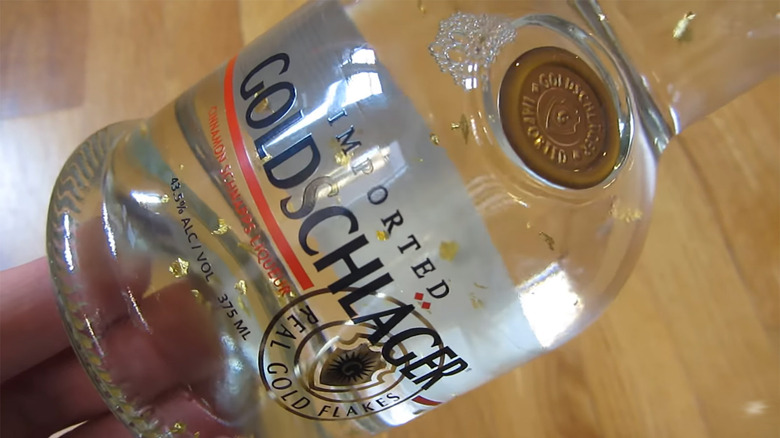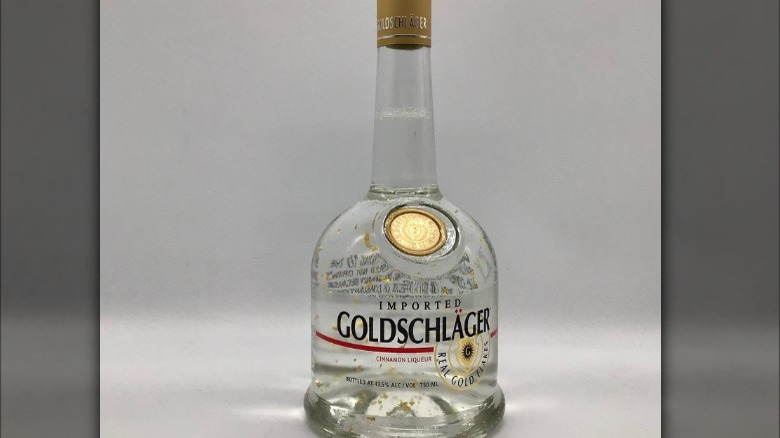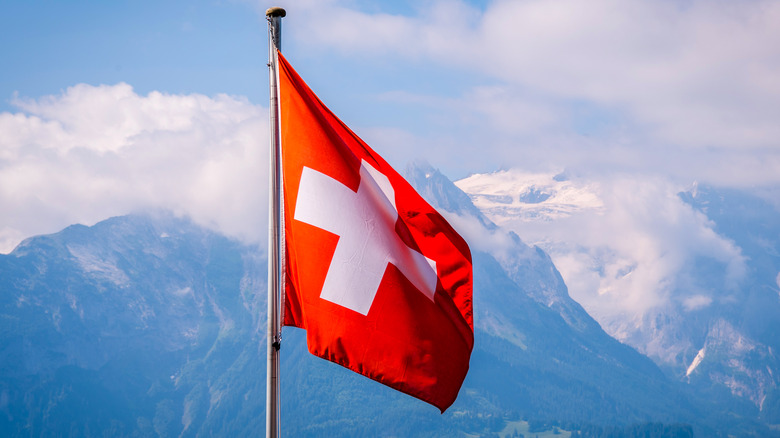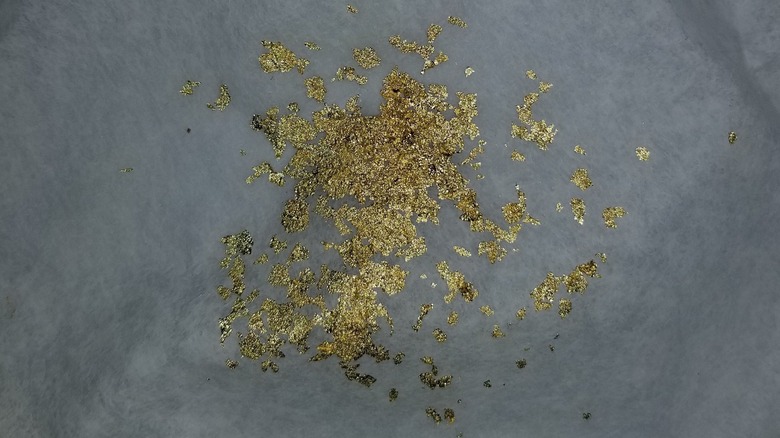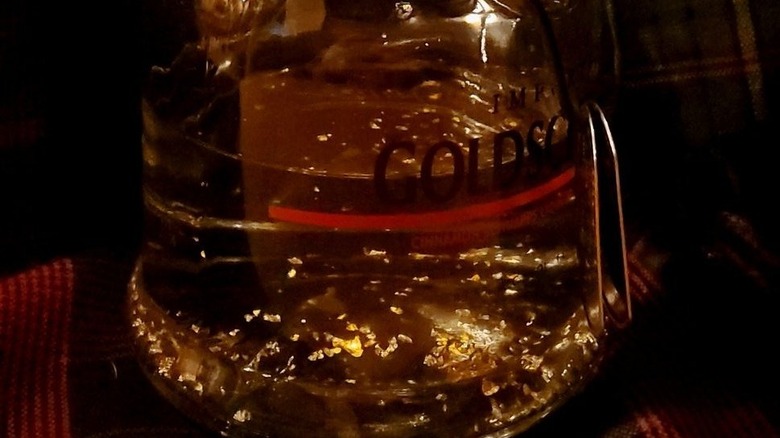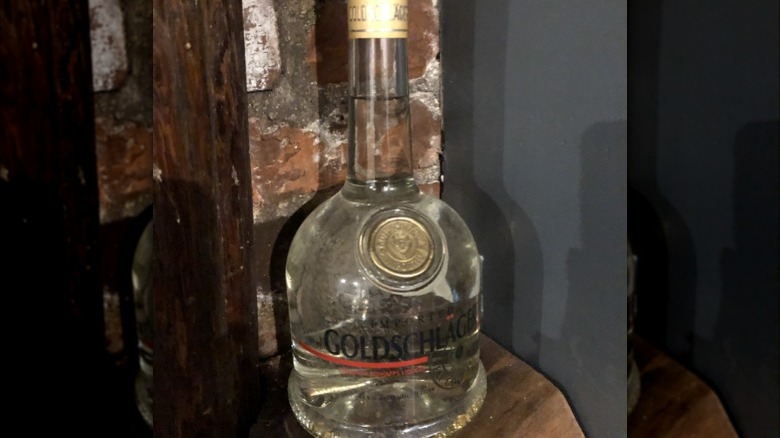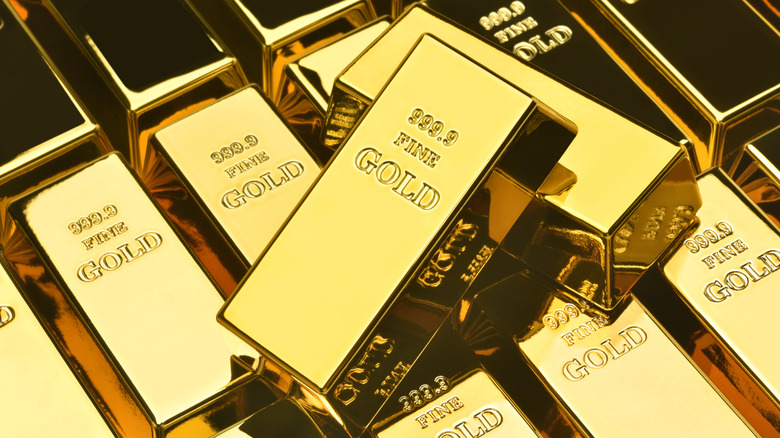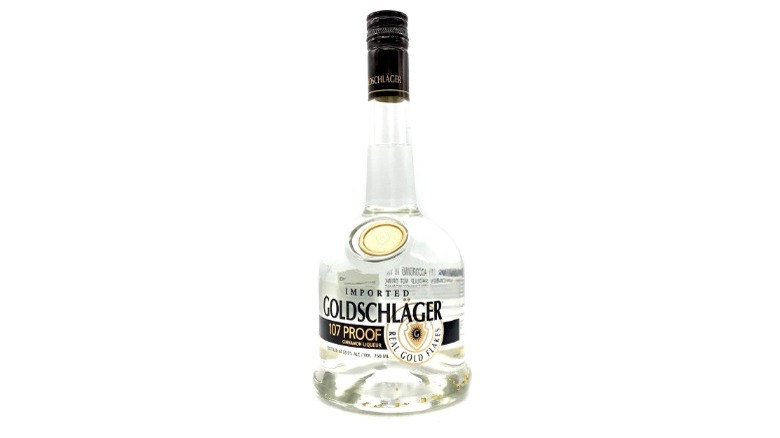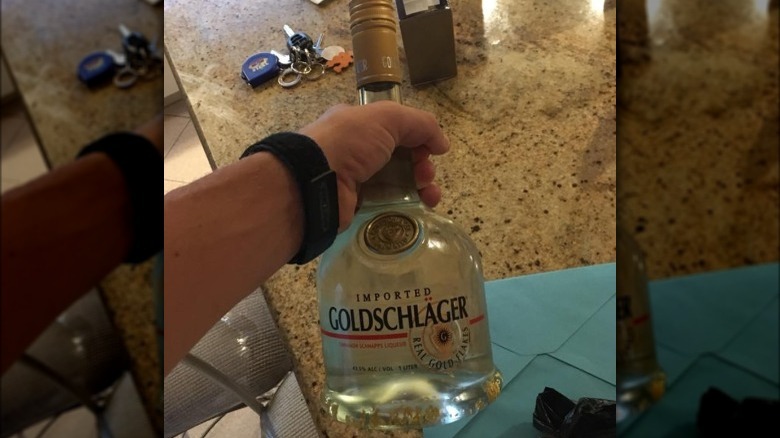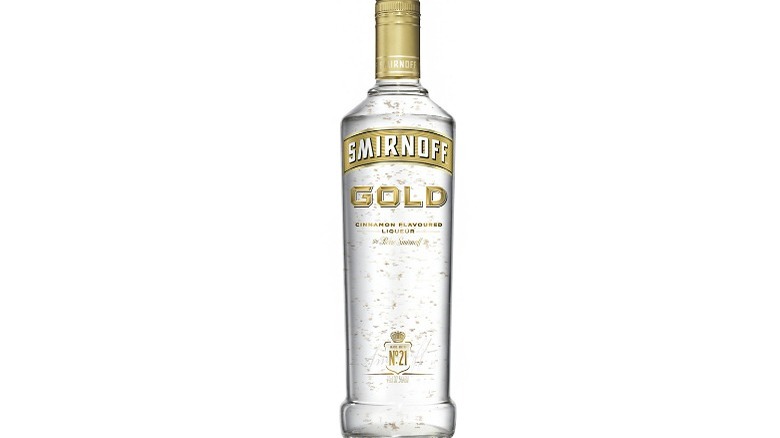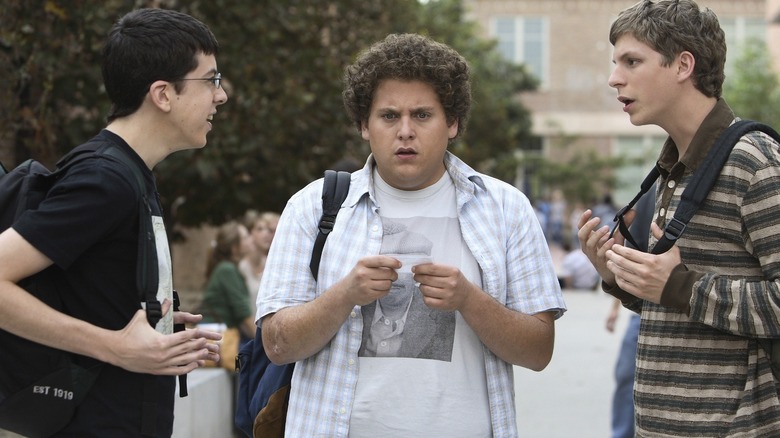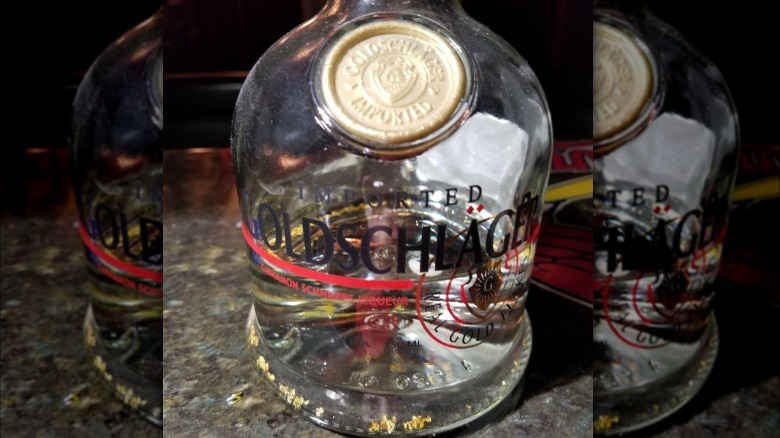The Only Goldschlager Bottle Guide You Need
By and large, the allure of gold (in any context, really) is rather apparent. While humans aren't instinctively attracted to shiny objects like some birds (allegedly) are, the precious metal's aesthetic appeal is obvious. Still, unless you're a Mike Myers character who loves "gooold" (or, well, a certain former president of the United States) it's worth remembering a little gold goes a long way. Thankfully, whoever originally conceived of Goldschläger — the popular cinnamon liqueur that contains "real gold flakes" in each bottle, according to its website — seemed to understand this notion.
Now, we're not saying a drink that calls for authentic gold in its recipe is somehow lacking in ostentatiousness. But we can't help but conclude the liqueur's manufacturers recognize the need for some restraint. After all, Goldschläger (which means "gold beater" in German, according to the book "Gold: A Cultural Encyclopedia") resembles a boozy snow globe with flitting gold flecks — not some disconcertingly overwhelming blur of nothing-but-gold.
Of course, whether or not you've consumed Goldschläger after turning 23 (has anyone?), you're likely somewhat acquainted with this iconic alcohol brand. But for anyone intrigued about the nitty-gritty details behind this fiery, cinnamon-flavored beverage — or eager to relive their youthful, uninformed drinking days, perhaps — look no further. Without further ado, we proudly present the only Goldschläger bottle guide you need.
Goldschläger is a cinnamon-flavored, high-proof (possibly schnapps?) liqueur
While the uninitiated might imagine a brand bursting with golden flavor, Goldschläger doesn't, in fact, taste like gold — largely because edible gold is quite literally devoid of any flavor (via Maclean's). Still, if you're unaware what the legendary alcohol tastes like, a quick perusal of its bottle reveals Goldschläger to be a cinnamon liqueur.
Now, unfortunately, we weren't able to find any information regarding the actual ingredients in Goldschläger. But the fact it's a liqueur (rather than a liquor) indicates it contains a number of additional components beyond a base alcohol. After all, liqueurs are merely liquor that's been made (presumably) more palatable through added flavoring agents. Whatever the process, though, the result is the slightly sweet, cinnamon-heavy, thick and syrupy liquid found in every bottle. And with a shockingly high 43.5% alcohol by volume (or 87-proof) to boot, it's more than just cinnamon that makes the beverage burn.
Additionally, while it's often marketed as "Cinnamon Schnapps Liqueur" in U.S. stores (as seen on Wine-Searcher), the Goldschläger website displays a bottle labeled only "Cinnamon Liqueur." Given this, the term 'schnapps' may indicate the liqueur is simply categorized as an American-style schnapps on occasion for U.S. consumers, as described by Virginia Alcohol Beverage Control Authority. In other words, while we weren't able to confirm this, it seems unlikely that Goldschläger is a genuine, German-style schnapps.
Goldschläger was originally produced in Switzerland until the 1990s
Certain names simply scream 'American' ... and quite frankly, Goldschläger isn't one of them. Of course, there's an exceptionally good reason for that: the liqueur isn't a U.S.-made alcohol, but a brand originating in Switzerland (via McGill University). Now, while the gold-infused spirit was indeed manufactured in Switzerland until the 1990s, it hasn't remained that way. And after beverage company Diageo purchased the brand during the '90s, it moved Goldschläger's production to Italy, according to the Shannon L. Kenny-authored book "Gold: A Cultural Encyclopedia."
Exactly why the international conglomerate Diageo (which owns countless alcohol brands, including Johnnie Walker) felt the need to change the location of the cinnamon liqueur's manufacturing facility is decidedly unclear. But the choice to begin producing the Swiss-originated alcohol in a different European nation was made.
By 2008, production of Goldschläger had returned to its native Switzerland (via VinePair), though it didn't remain there. In fact, when the brand was acquired by Sazerac Company in 2018, its production location appeared to shift once again. As Sazerac brand director Julia Watson told Wine Enthusiast in 2021, Goldschläger was being made in Montreal, Canada by that time — where its production likely remains as of 2023.
Rumors about the potential dangers of ingesting gold have persisted through the years
If you're like us, you vividly recall a number of school assemblies warning against tobacco use, including smokeless (or chewing) tobacco. And while tobacco's health risks are indeed vast and real, one notable (untrue) rumor always stood out: that chewing tobacco contains fiberglass, which cuts your gums, thus speeding up the absorption of nicotine into the bloodstream. Now, this notion is patently false, of course (via TobaccoHarmReduction.org). But that urban legend may help illustrate why so many folks are willing to believe the gold flakes in Goldschläger can cut you from the inside — a rumor that, like fiberglass-in-tobacco, is completely untrue (via Snopes).
Whether you've heard that Goldschläger's titular gold slices your throat, esophagus, or stomach, the bottom line is the gold flakes won't lacerate any part of a person's digestive tract. After all, despite being categorized as a heavy metal, gold is immensely pliable, according to BBC, meaning the gold flakes in Goldschläger are too soft to cause any damage.
Additionally, after some rumors suggested ingesting gold could be toxic, the amount added to each bottle of Goldschläger was reduced, according to the book "Gold: A Cultural Encyclopedia." In other words, you can rest easy knowing the gold flakes won't cause internal damage of any sort.
It's not nearly as expensive as the gold flakes seem to indicate
It doesn't take a connoisseur of the rich and famous to understand that gold (and gold-derived items) aren't cheap. Then again, while gold is far from inexpensive, that doesn't mean you need to prepare for sticker shock when you reach for a bottle of Goldschläger. After all, despite the presence of real gold flakes, the cinnamon liqueur is quite affordable, with a one-liter bottle costing $28.99 from Total Wine as of January 2023.
Obviously, the driving force behind any misconceptions surrounding the price of Goldschläger is, well, the gold found in each bottle. And, to be sure, the precious metal can be costly, with the price of gold averaging more than $1900 per ounce as of January 2023 (via Gold Price).
But the fact that a bottle of Goldschläger only contains around one-tenth of a gram of gold (via Manhattan Gold & Silver) — which equals six dollars or so as of January 2023 — shows it's a fairly benign concern, financially speaking. So if you've been avoiding Goldschläger because you're worried the included gold drives up the price, fret no more: You won't have to break the bank to feel the liqueur's cinnamon sting.
Goldschläger appears to be derived from the 16th-century liquor goldwasser
Where, exactly, did Goldschläger come from? Well, to be perfectly honest, we're not entirely sure. Despite our best efforts, we weren't able to find any information regarding the specifics behind when, why, and by whom Goldschläger was first produced. But, if nothing else, we can potentially ascertain where the idea for an alcohol featuring gold flakes was derived, because the cinnamon liqueur brand likely descended from a historic Eastern European alcohol known as "goldwasser" (via McGill University).
First made in 1598, goldwasser has traditionally been produced in the Polish city of Gdańsk (which was known as Danzig before World War II, according to the U.S. Holocaust Memorial Museum). Yet even with a 16th century origin, goldwasser may not have been the first instance of gold being incorporated into a beverage for aesthetic purposes. In fact, according to the book "Gold: A Cultural Encyclopedia," some evidence suggests ancient Egyptian pharaohs added gold to their wine for decadence, as well.
As we noted, we weren't able to find any proof of a direct lineage between Goldschläger and goldwasser. But frankly, it seems like an easy leap of logic to conclude the cinnamon liqueur was, at the very least, partially inspired by the part-Polish, part-German goldwasser.
Each bottle contains approximately six dollars worth of gold as of 2023
Deciding the best possible path to save money for one's retirement can be enormously stressful, particularly for folks living paycheck to paycheck, who are unable to set aside money for their golden years. Of course, this financial reality may help explain, in part, why get-rich-quick schemes are so prevalent. But if your shortcut to economic prosperity involves hoarding bottles of Goldschläger — you know, because it contains gold — we're sorry to spoil your party. Because while Goldschläger does contain real gold, there's a mere one-tenth of one gram in each bottle (via Manhattan Gold & Silver).
Now, if you're not up to date on the day-to-day pricing of gold (the audacity!), you may not realize that one-tenth of one gram of gold is not very much. But, as of January 2023, the price of gold per gram in the U.S. is around $61 (via Gold Price) — meaning each bottle of Goldschläger contains roughly six dollars worth of genuine gold.
But when you consider a bottle of Goldschläger will run you $27.99 from Drizly as of January 2023, you'll see that there's no profit margin to make the endeavor worthwhile. So if you adore Goldschläger as a beverage, stock up with glee. Just don't expect to strike it rich like a 19th-century miner during the gold rush.
There's also a 107-proof version for the more adventurous drinker
It's not exactly enlightening to say some individuals enjoy drinking alcohol more than others — as in, they literally consume higher quantities of alcohol, and stronger cocktails, than the average drinker. Still, those people exist (whether or not they can actually handle that extra alcohol). So if you're eager to enjoy the searing cinnamon flavor found in classic Goldschlager ... but, preposterously, don't find its 87-proof (or 43.5% ABV) sufficient? Simply reach for the stronger, 107-proof version that's also available (via Goldschläger).
Now, while we subscribe to the theory of "to each their own," we can't really conceive of any legitimate reason why a person would need to sip on an alcohol with more than 50% ABV. To be perfectly honest, we're not sure we understand precisely why anyone would need to drink an alcohol that contains a whopping 43.5% ABV, either, as the original Goldschläger does.
Still, someone out there must enjoy such a product. And we suppose if you'd like Goldschläger shots to get you truly crunk (as the kids almost certainly no longer say), it's nice to know there's the 107-proof option available. We may not find it necessary to drink a cinnamon-forward drink with such a staggeringly high alcohol content. But if that's your cup of tea, a 750-mL bottle is available for $25.99 as of January 2023 from Wine to Ship.
Goldschläger experienced a peak of popularity during the 1990s
Everyone has their favorite decade, though which 10-year span a person prefers is dependent on a potentially infinite number of subjective factors. Of course, for us here at Mashed (or, at least, some of us), it's common knowledge that no decade can top the 1990s. After all, that unrivaled era didn't just give us Crystal Pepsi and Hanson; it was also a time when Goldschläger was seen as a classy, in-demand alcoholic beverage (via Wine Enthusiast).
Now, if you weren't alive during the 1990s — or weren't yet drinking during that time (whether or not you were over 21) — you may not realize the decade represented a peak of sorts for Goldschläger. But as veteran bartender Bo Wayne told Wine Enthusiast in 2021, the mid-to-late '90s was a time when folks were "constantly doing shots of Goldschläger."
Of course, Goldschläger hasn't disappeared by any means since the turn of the millennium, to the shock and surprise of some (via Brutal Hammer). But anyone who recalls the liqueur's glory days may be disappointed with its current lot. Then again, since all-things-1990s appear to be cool again in the 2020s, perhaps Goldschläger's time will once again come.
It's not the only alcohol brand that contains gold flakes
As you're likely aware by now, Goldschläger was hardly the first alcoholic beverage to include (and highlight) gold flakes; the traditional alcohol goldwasser has it beat by several centuries, after all (via McGill University). But if you were under the impression the cinnamon liqueur was the only gold-enhanced alcohol sold on the market in the 21st century, you'd be mistaken, as a number of other brands also produce (and sell) alcohol with gold flakes.
This includes the cinnamon-flavored Smirnoff Gold, which some on Reddit speculate tastes like a thinner, less cinnamon-forward alternative to Goldschläger. Of course, those two gold-accentuated alcohols aren't the only two on the market. According to Drink Me Magazine, several other varieties can be found, including (but not limited to) Goldwasser Danzig Liqueur, Gold Flakes Supreme Vodka, and Gold Cuvée Wine.
Of course, unless your only interest is the appearance of gold flakes (which it just might be), we'd advise you to stick with the brand you know will deliver — i.e., grab a bottle of Goldschläger.
The 2007 film Superbad memorably used a fictional stand-in for Goldschläger
It's been more than 15 years since we first met the unrivaled McLovin (Christopher Mintz-Plasse) in the almost-too-close-to-home comedy classic "Superbad." And while it's abundantly clear why a nerdy high school student would choose a one-name pseudonym (is he Seal?), we've never understood why the film's McGuffin (not McMuffin) alcohol brand Goldslick vodka wasn't simply Goldschläger. But there's a perfectly reasonable explanation: the production team wasn't able to "clear Goldschläger" in time for filming, as Seth Rogen mentioned on Twitter in 2017.
In other words, the fictional vodka — which drives Evan (Michael Cera) throughout the film, as he attempts to obtain a bottle for his crush Becca (Martha MacIssac) — was clearly meant to invoke memories of the cinnamon liqueur. But it's more than nostalgia for high school drinking days (and those favored spirits of the young, unrefined palate) that made Goldslick memorable. Frankly, Goldslick is involved in some of the film's greatest moments. The various scenarios Seth (Jonah Hill) imagines himself in to illegally obtain alcohol as a minor, for example, or Evan's desperate dive trying to save an errantly-tossed Goldslick bottle on the bus, continue to induce uncontrollable fits of laughter all these years later.
Perhaps, though, the fact "Superbad" reflects real-life high school desperation to a T is the main reason why Goldslick resonated — because what teenager wouldn't go to such lengths to deliver for their crush?
The brand was acquired by Sazerac Company in 2018 as part of a $550 million deal
The exact origins of Goldschläger are nearly impossible to find. But while the initial group behind the cinnamon liqueur's creation remains a mystery, the company behind its manufacturing and distribution in 2023 is much easier to decipher. After all, Goldschläger is owned and distributed by Sazerac Company, according to its website.
Sazerac has owned Goldschläger since 2018, when the company purchased the brand from Diageo (via Reuters). It wasn't solely Goldschläger that piqued Sazerac's interest, though, and the cinnamon liqueur wasn't the only brand acquired during the deal. In fact, the gold-flaked alcohol was sold alongside Seagram's VO Canadian whisky as part of a staggering $550-million-dollar deal that year.
Now, as the company's brand director Julia Watson told Wine Enthusiast in 2021, the reason Sazerac was eager to obtain Goldschläger was "for the gold, of course." Unsurprisingly, then, Sazerac maintains ownership of the Swiss-born liqueur, and proudly champions the brand on its website. And while Sazerac falsely describes the gold flakes as "palatable" — an impossibility, given gold is completely flavorless (via Maclean's) — we won't knock a business for taking liberties with its product presentation. After all, the claim is as harmless as gold-as-food.
